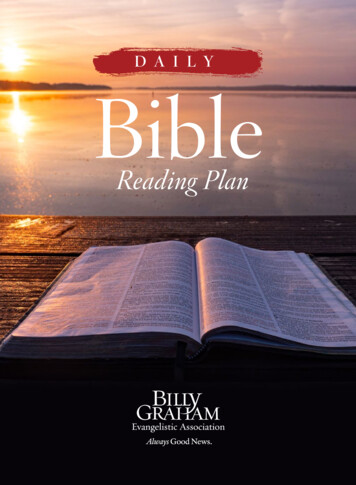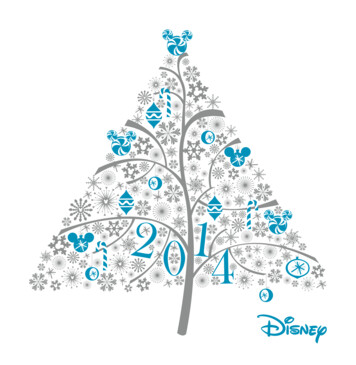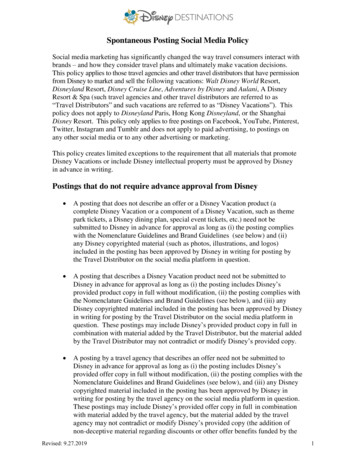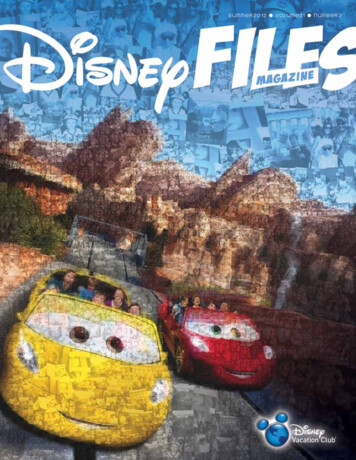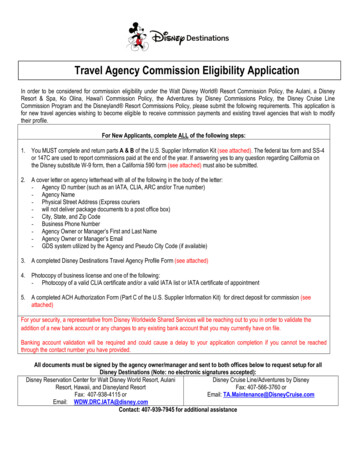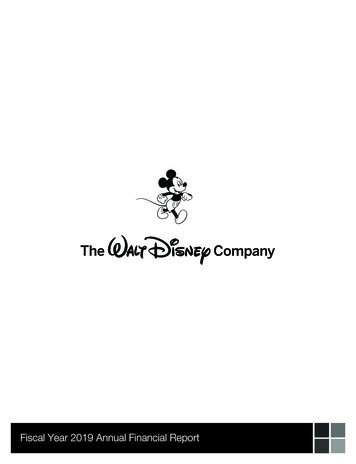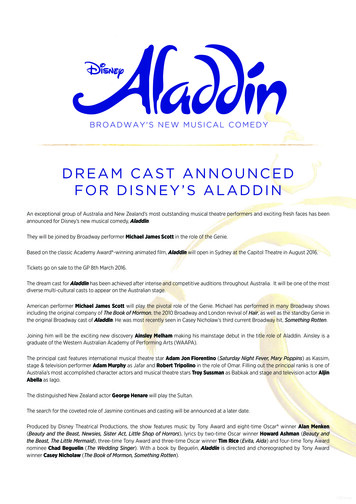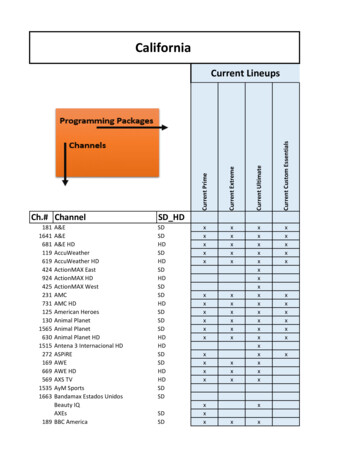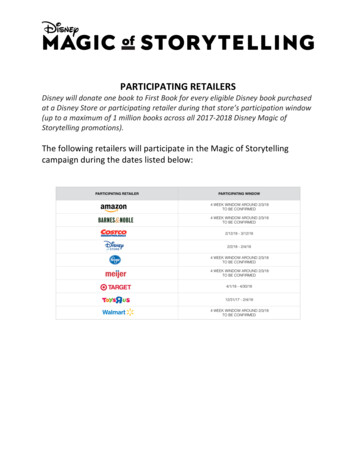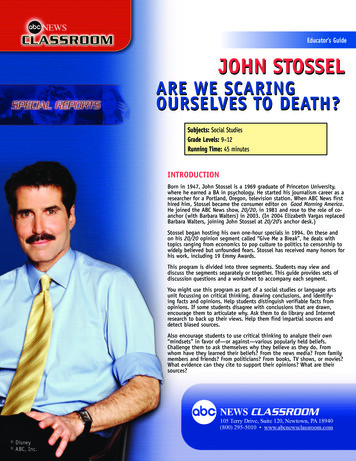
Transcription
Educator’s GuideJOHN STOSSELARE WE SCARINGOURSELVES TO DEATH?Subjects: Social StudiesGrade Levels: 9–12Running Time: 45 minutesINTRODUCTIONBorn in 1947, John Stossel is a 1969 graduate of Princeton University,where he earned a BA in psychology. He started his journalism career as aresearcher for a Portland, Oregon, television station. When ABC News firsthired him, Stossel became the consumer editor on Good Morning America.He joined the ABC News show, 20/20, in 1981 and rose to the role of coanchor (with Barbara Walters) in 2003. (In 2004 Elizabeth Vargas replacedBarbara Walters, joining John Stossel at 20/20’s anchor desk.)Stossel began hosting his own one-hour specials in 1994. On these andon his 20/20 opinion segment called “Give Me a Break”, he deals withtopics ranging from economics to pop culture to politics to censorship towidely believed but unfounded fears. Stossel has received many honors forhis work, including 19 Emmy Awards.This program is divided into three segments. Students may view anddiscuss the segments separately or together. This guide provides sets ofdiscussion questions and a worksheet to accompany each segment.You might use this program as part of a social studies or language artsunit focussing on critical thinking, drawing conclusions, and identifying facts and opinions. Help students distinguish verifiable facts fromopinions. If some students disagree with conclusions that are drawn,encourage them to articulate why. Ask them to do library and Internetresearch to back up their views. Help them find impartial sources anddetect biased sources.Also encourage students to use critical thinking to analyze their own“mindsets” in favor of—or against—various popularly held beliefs.Challenge them to ask themselves why they believe as they do. Fromwhom have they learned their beliefs? From the news media? From familymembers and friends? From politicians? From books, TV shows, or movies?What evidence can they cite to support their opinions? What are theirsources?NEWS CLASSROOM105 Terry Drive, Suite 120, Newtown, PA 18940(800) 295-5010 www.abcnewsclassroom.com Disney ABC, Inc.
OBJECTIVES:The student will: explore ethical, philosophical, sociological, and economic issues such as responsibilities and powers that the U.S. government—as opposed to individual Americans and private businesses—should reasonably possess; use critical thinking to detect faulty logic and distinguish between fact and opinion; determine whether to accept sources’ opinions as valid, based on their credentials and the kinds of evidence they present; begin to develop the habits of mind that historians and scholars in the humanities and social sciences employ to study thepast and its relationship to the present in the United States; begin to become informed, responsible and competent citizens in our participatory democracy.ON THE DVD:Scene SelectionThe DVD is divided into 6 chapters. This allows the user to show the whole program or to enter at different points in the program.The educator’s guide is set up so that the program can be viewed a few chapters at a time. Following each segment, there arediscussion questions, as well as a student response sheet.DVD chapterapproximate lengthDVD chapter title15 minutesIs Crime Increasing?28 minutesWhy Do We Feel Crime is Increasing?35 minutesCorrelation is Not Causation49 minutesRanking Risks510 minutesEnvironmental Risks and the EPA66 minutesFreedom, Prosperity and SafetyAlso AvailableIncludes a segment from Teaching Tools for Microeconomics from John Stossel and another segment from Teaching Tools forMacroeconomics, Government and International Trade from John Stossel.ARE WE SCARING OURSELVES TO DEATH?-2- Disney ABC, Inc.
RISK AND PERSONAL SAFETYDVD Chapters 1 and 2 (13:00)Use with Response Sheet #1Concept: Marginal costs and benefitsWhy Do We Feel Crime is Increasing? - Chapter 2 (8:00)Concept: Supply and DemandTo have a safe society, we must spend money to solveproblems of crime, pollution, safety, etc. But how muchmoney should be spent for how much safety? Increasingsafety – like losing weight – is easy (cheap) at first andgets harder (expensive) the closer you get to the ideal;this is known as marginal costs and benefits.Economic freedom leads to prosperous societies with entrepreneurs vying for your business. Some enterprising personor business usually provides the services or products wedemand. Remember how quickly T-shirts with the slogan “ISurvived the Blackout” were available following the 2003electric power grid failure.Is Crime Increasing? - Chapter 1 (5:00)Concept: Analysis of statisticsConcept: Risk assessmentFor violent crime the FBI uses reported crimes, therebymissing all unreported crime. Nor do they account forincreases in population. The FBI reported that violentcrime is up 82 percent. The Justice Department surveyspeople at random, and, in doing so, finds many unreportedcrimes. They also account for population increases. TheJustice Department found that violent crime is down 2percent.With television channels dedicated solely to news, we nowhear much more about crime than in the past. Crimes thatpreviously were only reported in local media now receivenational coverage. It “feels” as if there is more crime eventhough statistics don’t support that perception.Discussion Questions:1. How have changes in communications technologycontributed to the perception that criminal activities are increasing?Concept: Formation of public opinionThe media are at liberty to choose crime statistics fromany source. If, for example, they choose the FBI statisticsand ignore those of the Justice Department, how does thatinfluence how public opinion and public policy are shaped?Why would the news media favor one set of statistics overanother?2. What changes in people’s behavior have resultedfrom fear of crime?3. How have entrepreneurs in the classic supply-anddemand fashion responded to the perception thatcrime is increasing?Discussion Questions:4. Do you agree with John Stossel that ‘What couldhappen” and “What is likely to happen” are quitedifferent?1. The sets of statistics on crime shown by JohnStossel suggest different conclusions. Does thatmean one set is wrong?2. Why would the news media favor some statisticsover others?3. Do advocacy groups, politicians and/or law enforcement personnel have anything to gain if crimeincreases?ARE WE SCARING OURSELVES TO DEATH?-3- Disney ABC, Inc.
WHY THE INCREASED FEAR OF RISK?DVD Chapters 3 and 4 (14:00)Use with Response Sheet #2Ranking Risks - Chapter 4 (9:00)Correlation is Not Causation - Chapter 3 (5:00)For example, the Washington Redskins football team has a15-0 record of “predicting” Presidential elections. In thelast home game before an election, if they win, the incumbent party is reelected; if they lose, the incumbent loses.Similarly, for example, we see food additives correlatedwith cancer. Do we overreact when things are correlatedwith cancer? Has it been established to be causal ormerely correlative?Concept: ScarcityConcept: Risk assessmentConcept: Statistical murderLife is risky. There is no human activity that does notinvolve some risk. Some risks are small; eating spaghettiwhen dressed in white. Some risks are great; riding abicycle at 30 miles per hour down a bumpy tree-linedpath. But by taking risks people add to human knowledgeand that leads to a “better tomorrow.”There is a regulation that requires parents to place infantsin a car seat on airplanes – in the name of safety. Thisleads many parents to drive instead of fly in order to savethe expense of purchasing an additional seat. Statistically,driving is significantly more dangerous than flying; therefore, the result will be more deaths than otherwise. This isknown as statistical murder.Airlines want their planes to be full of passengers payingthe highest possible price. It’s better for them to haveslightly fewer available seats (supply) than customers whowant to fly (demand). This is known as scarcity. Whengoods are scarce, sellers can charge more than when goodsare plentiful.Concept: Government regulationDiscussion Questions:Government can be looked at like any other business.It’s to the benefit of government agencies to always findproblems to solve. Unlike private businesses that go bankrupt if they fail to satisfy customers, government agenciesmarch along like the “Energizer Bunny.” Once government requires a solution, e.g., catalytic converters forcar exhaust, the incentive for innovation and better autoemission control is removed.1. Are you convinced that flying in airplanes is saferthan driving in a car? If not, why not?2. How does knowledge affect our sense of risk?3. Give some examples of statistical murder.Discussion Questions:1. Can government regulations keep us safe?2. Is freedom worth some risk? Should you be allowedto take the risk of riding a bicycle without wearinga safety helmet?3. Who’s going to determine what’s too risky to beallowed?ARE WE SCARING OURSELVES TO DEATH?-4- Disney ABC, Inc.
ENVIRONMENTAL AND OTHER RISKSDVD Chapters 5 and 6 (16:00)Use with Response Sheet #3Freedom, Prosperity and Safety - Chapter 6 (6:00)Environmental Risks and the EPA - Chapter 5 (10:00)Concept: Democracy and riskConcept: Resource allocation and innovationJohn Stossel shows the example of Aspen, Colorado, where,despite high lead levels in the soil, there was no historyof illness caused by lead. Although blood tests showedthat the lead levels of Aspen children were among thelowest in the nation, the EPA (Environmental ProtectionAdministration) still wanted to level houses and removefour feet of topsoil.If we focus our spending on efforts to achieve safety and“risk-free” living, what will happen to progress? Progress isdependent upon innovation, and innovation is born of risk.Allowing people to risk harm or financial loss may havebad consequences for the person involved but improve thelives of many others.Concept: Personal freedom vs. safetyConsider what former President Ronald Reagan said: “Thenine scariest words in the English language are: ‘We’re fromthe government and we’re here to help.’”Unintended consequences often accompany innovation.Once government mandates a safety requirement it is verydifficult to change. Air bags are required and they do savelives. But they have also killed infants and elderly folks. Ifgovernment didn’t require airbags people would be free tochoose between this added protection and the added riskto children and grandparents.Concept: Regulation and costsThe introduction of new drugs fell from an average of38 per year between 1951-62, to fewer than 17 per yearbetween 1963-90. By concentrating on reducing the riskfrom bad drugs, Congress and the FDA (Food and DrugAdministration) may have contributed to the death ofthose denied access to potentially lifesaving drugs.Discussion Questions:1. Should we trust scientists, government or ourselves?2. Do you agree with Stossel’s concern that fear of riskwill slow progress?Freedom to try things helps us determine how to make lifesafer. Should the early inventors of airplanes have beenprohibited from trying to fly because some who tried werekilled? Their mistakes led to the safe air travel we enjoytoday.3. Which do you value more, freedom or safety?Discussion Questions:1. Can there be too much government regulation?2. Should federal or state government be able to makecommunities act against their will?3. How do we judge science? Which evidence did youfind most convincing in the case of the lead in theAspen soil? Why?ARE WE SCARING OURSELVES TO DEATH?-5- Disney ABC, Inc.
RESPONSE SHEET #1(Discuss after watching Chapter 1 – Is Crime Increasing?and Chapter 2 – Why Do We Feel Crime is Increasing?)Use these questions as a starting point for discussion and further research. Also jot down any questions that come into your mindas you view the show.1. Refute the following statement: “Risk is bad, therefore, everyone benefits by having less risk.”2. How do scarcity and opportunity costs explain why certain public policies designed to reduce risk can increase risk?3. How do insurers protect against moral hazard and adverse selection?4. Mr. Stossel observes that gated communities reduce interaction between different groups. He later suggests that lack of familiarity leads to increased fearfulness and an increased perception of risk. Do the interview segments in the video support thoseconclusions? State an example from the video.5. Without talking about money, what does it cost you to live as part of a community? What are the benefits?ARE WE SCARING OURSELVES TO DEATH? Disney ABC, Inc.
RESPONSE SHEET #2(Discuss after watching Chapter 3 – Correlation is Not Causation and Chapter 4 – Ranking Risks.)Use these questions as a starting point for discussion and further research. Also jot down any questions that come into your mindas you view the show.1. Why do people fear risk?2. “Crime must be out of control because I see it every night on the news.” Critically evaluate this statement.3. We trust “experts” to tell us the truth. Critically evaluate.4. What role does expected punishment play in deterring crime?5. What do the thousands of new regulations tell us about politics?ARE WE SCARING OURSELVES TO DEATH? Disney ABC, Inc.
RESPONSE SHEET #3(Discuss after watching Chapter 5 – Environmental Risks and Safteyand Chapter 6 – Freedom, Prosperity and Safety.)Use these questions as a starting point for discussion and further research. Also jot down any questions that come into your mindas you view the show.1. Why does the FDA keep lifesaving drugs off the market and “statistically murder” thousands of people every year?2. “Public policy should reduce pollution and other risks to zero.” What does this tell us about the concept of scarcity and unintended consequences?3. On average, do new technologies pose more risk or less risk? Explain.4. What effects do regulations designed to enhance workplace safety have on the incentives to create wealth and higher wages?5. Some say that Superfund has become a “lawyers’ slush fund.” What do you think, and why?ARE WE SCARING OURSELVES TO DEATH? Disney ABC, Inc.
FINAL RESPONSE SHEET(Discuss after watching all six chapters.)1. Define the cost/benefit principle. Give an example in terms of risk/safety.2. Why is there an increased fear of risk? What steps can be taken to properly assess risk?3. What factors and/or policies are most likely to change criminal behavior?4. What issues must be considered when trying to reduce crime?5. Explain how regulations result in unintended consequences.ARE WE SCARING OURSELVES TO DEATH? Disney ABC, Inc.
KEY WORDS AND CONCEPTSadverse selectionriskcausationrisk aversecorrelationrisk takersDelaney Clausescarcitydiminishing marginal benefitsspurious correlationdrug lagSuperfundequilibriumtransaction costsheadline hysteriaType I errorinformation costsType II errormoral hazardunlimited desiresopportunity costvariancerational ignorancezero toleranceARE WE SCARING OURSELVES TO DEATH?-10- Disney ABC, Inc.
JOHN STOSSELARE WE SCARINGOURSELVES TO DEATH?SPECIAL THANKSABCNEWS Classroom acknowledges In The Classroom Media forits development of classroom materials for this title.In The Classroom Media1502 Powell AvenueErie, PA 16505www.intheclassroom.orgFOR MORE INFORMATIONVisit www.abcnewsclassroom.com.NEWS CLASSROOM105 Terry Drive, Suite 120, Newtown, PA 18940(800) 295-5010 www.abcnewsclassroom.com Disney ABC, Inc.
unit focussing on critical thinking, drawing conclusions, and identify-ing facts and opinions. Help students distinguish verifiable facts from opinions. If some students disagree with conclusions that are drawn, encourage them to articulate why. Ask them to do library and Internet research to back up their views. Help them find impartial .
